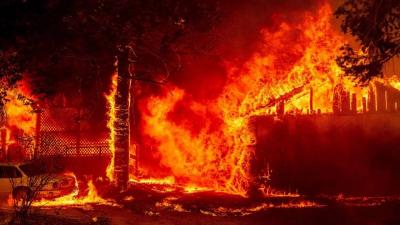The massive "Dixie Fire," raging in Northern California, has continued to grow, making it the second largest fire in the state's history, authorities announced yesterday, Sunday. While thousands continued to flee the rising flames, three people were still reported missing. As of yesterday, the fire had consumed 187,562 hectares, currently covering an area larger than Los Angeles and comparable in size to Maui Island in Hawaii. The "Dixie Fire" is the largest active wildfire in the United States, but it is one of 11 major fires in California.
Over the weekend, the "Mendocino Complex Fire," which ignited in 2018, was surpassed by the Dixie Fire, thereby becoming the second worst fire in state history, according to authorities. Tammy Kugler, sitting next to her tent at an evacuation site after fleeing the town of Greenville before the flames reached it, stated, "It was like walking out of a war zone you see in a movie." She added, "The neighborhood I live in is no longer there. Everyone I care about and love in that neighborhood, their homes are gone."
State Governor Gavin Newsom visited Greenville, which appeared charred on Saturday, expressing his "deep gratitude" to the teams battling the flames, stating that authorities need to allocate more resources for forest management and fire prevention. However, he added, "Drought is becoming more severe, and the weather is hotter than it has ever been... We need to directly acknowledge that these fires are a result of climate change."
As of Saturday, the Dixie Fire, which caused injuries to three firefighters, was 21% contained, unchanged from the previous day, according to the "Cal Fire" website. Fire officials estimate that the fire, which started on July 13, will not be extinguished for at least two weeks. Weak winds and high humidity offered some help to firefighters, but they are preparing for higher-than-expected temperatures that could exceed 38 degrees Celsius by mid-week.
Thousands of residents evacuated the area, with many finding temporary housing, even living in tents. The Plumas County Sheriff’s Office reported on Saturday that the search is ongoing for three individuals considered missing. On Saturday, five other missing persons were confirmed found. Over five thousand personnel are now involved in battling the "Dixie Fire."
By late July, the number of hectares burned in California had increased by over 250% compared to 2020, which was considered the worst year for wildfires in the state's modern history. This week, "Dixie" destroyed businesses and homes in the small town of Greenville and in Canyon Dam. Despite repeated evacuation orders issued by authorities, some residents insisted on combating the fire themselves rather than relying on strangers for their safety. Law enforcement is requesting the names of residents' relatives to notify them in case of fatalities in the fire.
"Weather Phenomena"
Jake Kagle, a California fire official, stated, "Our units continue to work around Silver Lake," a nearby location where firefighters occasionally rest. The Dixie Fire engulfed Greenville, which has a population of around 800, late Wednesday into Thursday. The prolonged drought, believed by scientists to be linked to climate change, has made the western United States vulnerable to these devastating fires.
"Dixie" has grown to the point where it generates its own weather phenomena, including lightning, complicating its path. Preliminary investigations indicate that the fire may have been sparked by a tree falling onto power lines. These lines belong to "Pacific Gas and Electric," a private company responsible for the "Camp Fire," which nearly wiped out the town of Paradise and resulted in 86 fatalities in 2018.
The "Dixie Fire" recalls the Paradise fire of 2018, the deadliest fire California has seen in recent years. Greenville appeared burned and destroyed on Friday, with wooden structures completely collapsed and some stone buildings reduced to ruins. Over five thousand firefighters are battling a fire that sends massive clouds of smoke visible from space. High winds, along with steep terrain and abundant dry vegetation, have fueled the flames, making firefighters' jobs more challenging.
Greenville has previously faced multiple disasters, with a massive fire destroying much of the town in 1881 and numerous dangerous fires threatening residents over the past 140 years.




